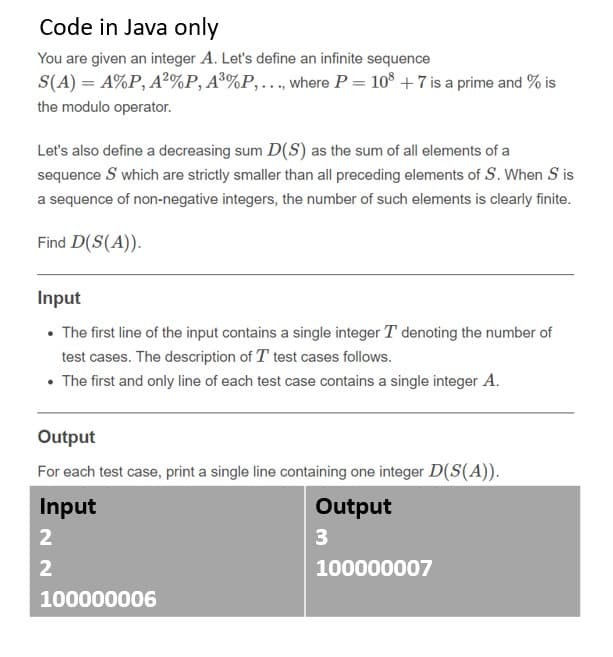Code in Java only You are given an integer A. Let's define an infinite sequence S(A) = A%P, A²%P, A®%P,., where P = 10* + 7 is a prime and % is the modulo operator. Let's also define a decreasing sum D(S) as the sum of all elements of a sequence S which are strictly smaller than all preceding elements of S. When S is a sequence of non-negative integers, the number of such elements is clearly finite. Find D(S(A)). Input • The first line of the input contains a single integer T denoting the number of test cases. The description of T test cases follows. • The first and only line of each test case contains a single integer A. Output For each test case, print a single line containing one integer D(S(A)). Input Output 3 2 100000007 100000006
Code in Java only You are given an integer A. Let's define an infinite sequence S(A) = A%P, A²%P, A®%P,., where P = 10* + 7 is a prime and % is the modulo operator. Let's also define a decreasing sum D(S) as the sum of all elements of a sequence S which are strictly smaller than all preceding elements of S. When S is a sequence of non-negative integers, the number of such elements is clearly finite. Find D(S(A)). Input • The first line of the input contains a single integer T denoting the number of test cases. The description of T test cases follows. • The first and only line of each test case contains a single integer A. Output For each test case, print a single line containing one integer D(S(A)). Input Output 3 2 100000007 100000006
Computer Networking: A Top-Down Approach (7th Edition)
7th Edition
ISBN:9780133594140
Author:James Kurose, Keith Ross
Publisher:James Kurose, Keith Ross
Chapter1: Computer Networks And The Internet
Section: Chapter Questions
Problem R1RQ: What is the difference between a host and an end system? List several different types of end...
Related questions
Question
code in java onlyy

Transcribed Image Text:Code in Java only
You are given an integer A. Let's define an infinite sequence
S(A) = A%P, A²%P, A®%P,., where P = 10° + 7 is a prime and % is
the modulo operator.
Let's also define a decreasing sum D(S) as the sum of all elements of a
sequence S which are strictly smaller than all preceding elements of S. When S is
a sequence of non-negative integers, the number of such elements is clearly finite.
Find D(S(A)).
Input
• The first line of the input contains a single integer T denoting the number of
test cases. The description of T test cases follows.
• The first and only line of each test case contains a single integer A.
Output
For each test case, print a single line containing one integer D(S(A)).
Input
Output
2
3
2
100000007
100000006
Expert Solution
This question has been solved!
Explore an expertly crafted, step-by-step solution for a thorough understanding of key concepts.
Step by step
Solved in 3 steps with 1 images

Recommended textbooks for you

Computer Networking: A Top-Down Approach (7th Edi…
Computer Engineering
ISBN:
9780133594140
Author:
James Kurose, Keith Ross
Publisher:
PEARSON

Computer Organization and Design MIPS Edition, Fi…
Computer Engineering
ISBN:
9780124077263
Author:
David A. Patterson, John L. Hennessy
Publisher:
Elsevier Science

Network+ Guide to Networks (MindTap Course List)
Computer Engineering
ISBN:
9781337569330
Author:
Jill West, Tamara Dean, Jean Andrews
Publisher:
Cengage Learning

Computer Networking: A Top-Down Approach (7th Edi…
Computer Engineering
ISBN:
9780133594140
Author:
James Kurose, Keith Ross
Publisher:
PEARSON

Computer Organization and Design MIPS Edition, Fi…
Computer Engineering
ISBN:
9780124077263
Author:
David A. Patterson, John L. Hennessy
Publisher:
Elsevier Science

Network+ Guide to Networks (MindTap Course List)
Computer Engineering
ISBN:
9781337569330
Author:
Jill West, Tamara Dean, Jean Andrews
Publisher:
Cengage Learning

Concepts of Database Management
Computer Engineering
ISBN:
9781337093422
Author:
Joy L. Starks, Philip J. Pratt, Mary Z. Last
Publisher:
Cengage Learning

Prelude to Programming
Computer Engineering
ISBN:
9780133750423
Author:
VENIT, Stewart
Publisher:
Pearson Education

Sc Business Data Communications and Networking, T…
Computer Engineering
ISBN:
9781119368830
Author:
FITZGERALD
Publisher:
WILEY